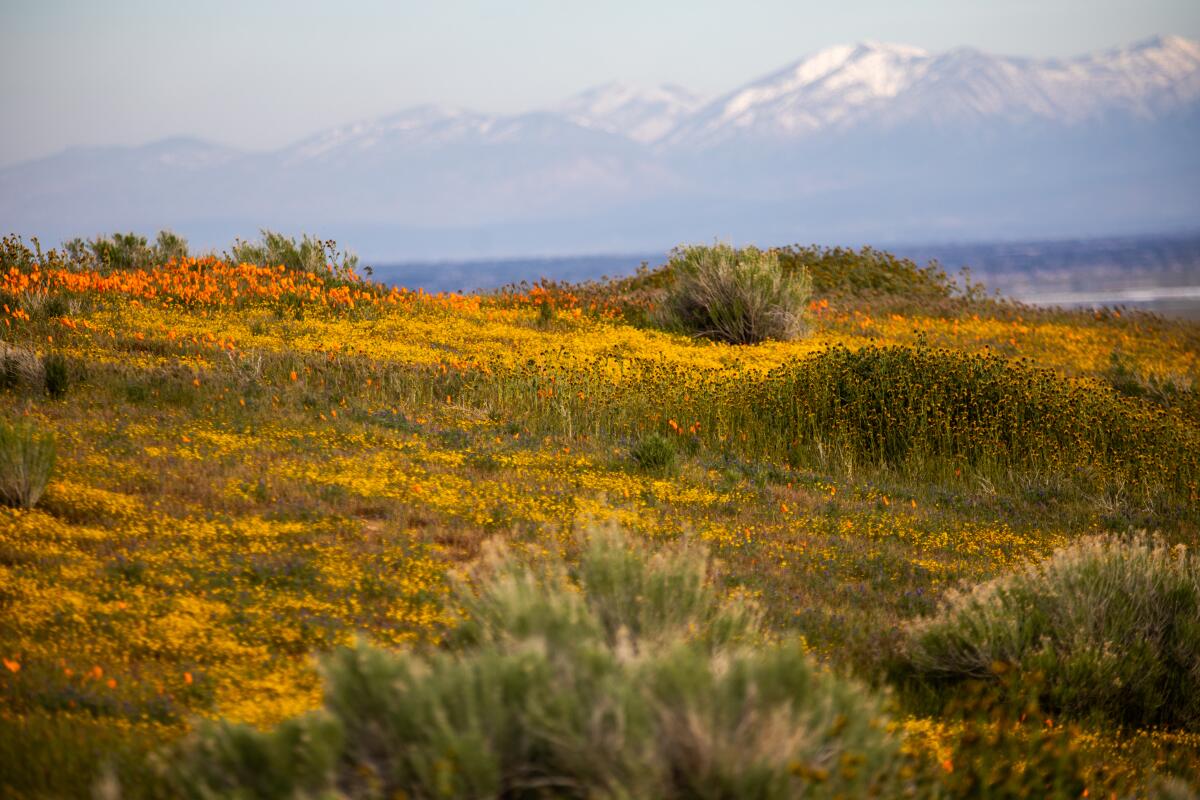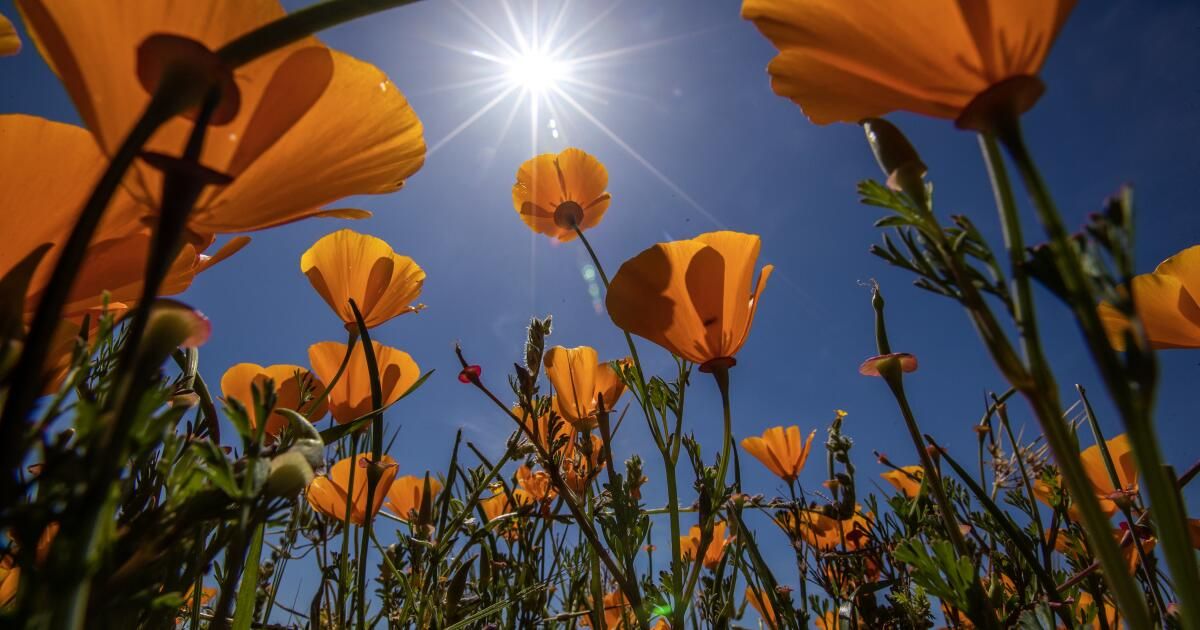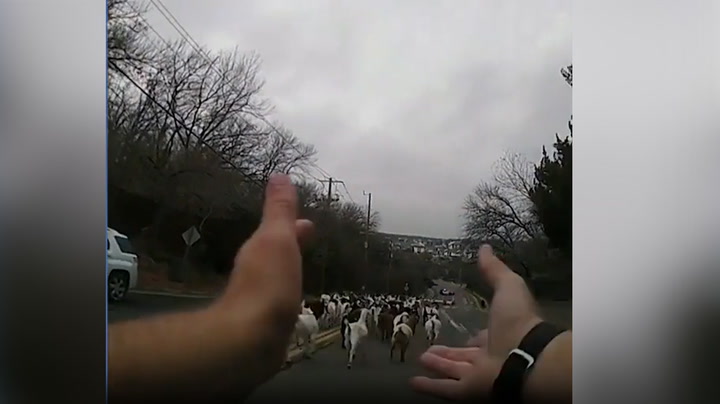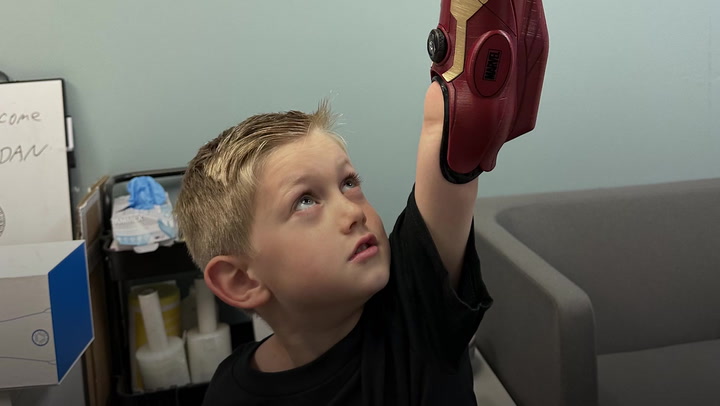Scan the hills of the Antelope Valley California Poppy Reserve and you'll notice something is missing.
Golden poppies.
Even as Instagram-worthy wildflowers bloom across the state, the resplendent orange blossom has been conspicuously absent from some of its usual haunts, including the Lancaster Reservation and the town of Lake Elsinore.
“This year doesn't look like it's going to be a great year for poppies,” said Callista Turner, an interpreter at the state nature preserve that hugs the western edge of the Mojave Desert. She stood outside the reserve's visitor center and pointed out fields that lacked orange spots on a video call this week.
It may seem contradictory. Storm after storm has battered California, prompting wildflower fans earlier this year to cross their fingers for a super bloom. But more rain doesn't mean more growth for all plants.
A deluge of water can boost invasive grasses and plants, which outcompete native plants that need optimal conditions to thrive. The poppy, in particular, doesn't seem to come off.
Lake Elsinore's Walker Canyon, about an hour and a half drive southeast of Los Angeles, erupted with a brilliant superbloom last year, prompting city officials to close the popular destination for fear of a crush of tourists. This spring, the mountains are relatively bare. (As a precaution, city officials also closed the area this year.)
A close-up view of California poppies blooming in early 2023 on the upper slopes of Walker Canyon in Lake Elsinore. This year, the mayor of Lake Elsinore said conditions were not conducive to the growth of the perennial orange blossom.
(Allen J. Schaben/Los Angeles Times)
“The California poppy is temperamental; It requires certain conditions to flourish,” Lake Elsinore Mayor Steve Manos said recently. “This year, those conditions just didn't manifest themselves here in the city of Lake Elsinore.”
The timing of rainfall, a plant's growth strategy and regional differences affect which plants bloom in a given year, said Joan Dudney, associate professor of global change ecology at the University of California, Santa Barbara.
In fact, native plants tend to do better after several years of drought, once invasive species not adapted to the arid climate disappear. That's why the 2017 superbloom was so spectacular, Dudney said.
Dudney added that the seeds of some native flowers can remain dormant for a long time and do not necessarily germinate even under ideal conditions. It is an adaptation that allows them to survive climate variability. A large proportion of invasive grass seeds produced the previous year germinate no matter what. This time it paid off: a second consecutive rainy year has allowed them to prosper, outperforming their competitors.
“I was expecting that we would see a little bit of decreased flowering this year, simply because we had a lot of seed production from non-native grasses last year,” Dudney said.
But it's not all doom and gloom across the state. Desert areas where native plants have less competition are inundated with wildflowers. Sand verbena, desert sunflowers and desert primrose recently dazzled onlookers along Henderson Canyon Road in Borrego Springs, an area famous for wildflowers in San Diego County. However, the peak of those blooms has already passed.
According to Dudney, the intensely alkaline soil of the Carrizo Plain National Monument, a remote prairie east of San Luis Obispo, also deters invaders from thriving. Blooms there have started to peak at lower elevations, and Dudney said they look good, but so far they're not as robust as last year.
Some still hold out hope for a change towards the end of the season. The late rains and cold weather that characterized this spring may delay or hinder blooms. Warming combined with dry skies could produce flowers, including poppies.
Turner, from the Antelope Valley Poppy Reserve, isn't holding his breath.

A variety of colorful wildflowers bloomed last April at the Antelope Valley California Poppy Preserve in Lancaster.
(Francine Orr / Los Angeles Times)
“It looks like we probably got too much water,” he said. Even more rain is expected this week. Invasive plants like mustard are pulled out to keep them at bay, but they are tenacious.
There aren't many small poppies in the protected open space, which Turner said indicates that what you see now is probably what you'll get for the rest of the season. (You can spy on the fields through a poppy live cam.)
Sometimes there are actually greater concentrations of poppies on private land outside the reserve, a phenomenon that Turner says can result from grazing by sheep and cattle. Poppies like the disturbed soil created by heavy hoof work and snout nipping. Bulbs and other sensitive flowers do not grow well in such soil.
Determining the peak of the blooms is tricky: It could be happening now or in a week or two, he said. Predictions are based on decades-old data, but climate change is disrupting reliable patterns. There are now greater swings between intensely hot, dry conditions and cold, wet conditions.
While it may not be the year of the poppy, Turner said there are plenty of other flowers worth admiring. Expanses of the reserve are covered in tiny yellow flowers called golden fields. Zooming in on certain areas during the video call with her brought into focus patches of sun-colored flowers in the fields and hillsides. A lone patch of orange poppies was also visible.
Iridescent cream cups, “always a fan favorite,” emerged last week. There are beautiful scented popcorn flowers as well as grape soda lupins that bloom at Tehachapi Point every year.
Additionally, the California poppy is just one of several types of poppies in the state. There are also desert poppies and tufted poppies, Turner said.
“It's a beautiful season for wildflowers. I just wouldn’t get too obsessed with poppies,” she said. “Take advantage of this year to find another wildflower and enjoy it.”
Do you want to see wildflowers in Southern California? Do your research and plan ahead to avoid disappointment.
- Browse California State Parks flower bloom updates. The free online resource summarizes the wildflower situation at Anza-Borrego Desert State Park, Red Rock Canyon State Park, Chino Hills State Park and more.
- Call the Theodore Payne Foundation Wildflower Hotline, which is updated every Friday until June. The number is (818) 768-1802, ext. 7.
- See the Antelope Valley California Poppy Preserve live camera to get an idea of what you might see.
- Check the weather. Storms can ruin a trip. This week, winds of more than 30 mph were expected in the Antelope Valley poppy preserve, not ideal conditions for viewing the flowers.
- Do not pick or trample the flowers. Not even for a cool Instagram photo.












